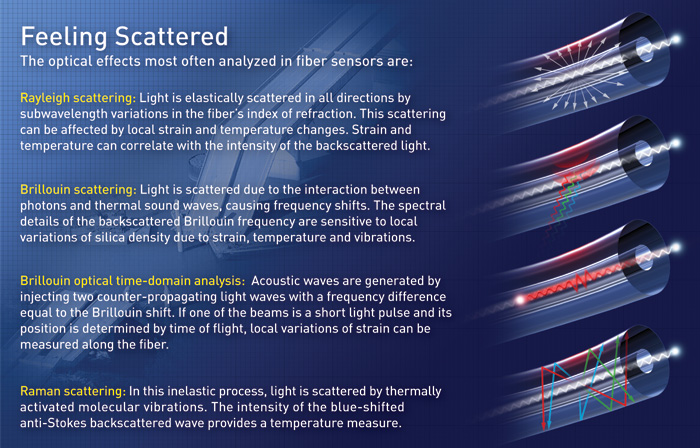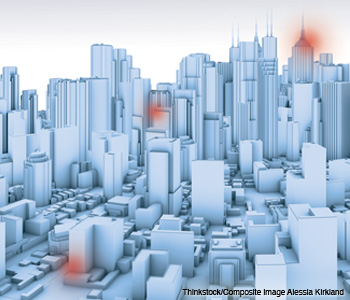
Not to alarm you, but the building you’re sitting in may not be safe. The same holds true for the bridge you drove over getting to work and the dam just outside of town. These structures and others are continuously subjected to both common and uncommon stresses and strains that produce flaws. Everything from the weight of people, furniture and machinery to the forces exerted by fires, floods and earthquakes have an effect. Simple cracks and fissures may appear at first due to heavy loads; over time, these will lead to failure.
Manual inspections are par for the course when engineers are trying to determine the safety of buildings and other edifices. However, they are time-consuming and labor-intensive. Moreover, most city, town and state governments are not able to pay for enough inspectors to perform the work on a regular basis. Even if they were, inspections would cover only the easy-to-see exteriors. Most wear and tear, however, starts between walls, or even inside them.
Fortunately, fiber-optic technology provides another alternative. Since standard telecom-grade fiber optics are sensitive to stress, strain, temperature and other deleterious factors, they can be used to monitor buildings, bridges and dams in real-time. The field is known broadly as civil structural health monitoring or simply structural health monitoring (SHM).
Fiber-optic sensor systems react to changes in their environment through minute alterations of their refractive indices as light travels through them. Often, this is achieved by adding fiber Bragg gratings at discrete points along the length of the system. Passing light through a fiber that is attached to a wall, floor or other surface reveals nothing until the surface changes.
However, when a wall shifts—through simple settling or perhaps via a mild temblor—its shape is minutely displaced, resulting in a similarly tiny variation in the light path provided by the fiber. The way in which these changes are measured depends on the anticipated effect, such as stress or temperature. The three optical effects most often analyzed in fiber sensors are Rayleigh, Raman and Brillouin scattering.
Depending on the design of the fiber and the method of reading the output spectra, an engineer can determine the total forces acting on a structure and thus judge whether it is in need of repair.
When the input light is provided by a pulsed laser, the location of the spot on the fiber that experienced the change can be determined with relatively good spatial resolution—usually depending on the distance between the stress point and the scanner reading the output.
|
|
|
||||||||||||||||||||||
System options
Bridges, buildings and anything else made of concrete and steel are constantly subjected to static and dynamic loads. Even a stiff breeze against an empty office building sets off a sequence of stresses, strains and temperature changes within the floors, walls and foundation. Over time, these forces take their toll, cracking and shearing the materials.
Selecting the correct fiber-optic sensor to monitor these forces is important for maintenance, as well as for giving civil engineers insight into how to adjust future designs.
“There are several technologies that allow monitoring of these parameters,” said Branko Glisic, a professor of civil and environmental engineering at Princeton University, “and selection of (the) right technology depends on several factors.”
Other technologies, including piezoelectric sensors, are used in some structures as stress gauges. Telecom-grade optical fiber, however, was found to be more durable than electromechanical devices, less sensitive to humidity and corrosion and, perhaps most important, completely impervious to electromagnetic interference.
Fiber optics are also preferred for monitoring structures—including pipelines—in the oil and gas industry, Glisic said, because they are electrically passive and therefore won’t ignite stray gasses.
Discrete point sensors are used to monitor small pockets of localized material, whereas discrete long-gauge sensors assess more global structures, especially where the construction material is not homogeneous, such as with concrete. Distributed sensors, which are sensitive at every point along their length, are largely used for assessing the integrity of large structures, including long bridges, pipelines and dams, especially where integrity loss is equally likely to happen at any cross-section of the structure, Glisic said. One distributed sensor can replace a multitude of point sensors, but the latter have their advantages as well.
“Fiber optics is the only technology that provides true long-gauge and distributed sensors,” he noted.
The most popular discrete sensors are based on fiber Bragg gratings because they offer in-line multiplexing and the ability to measure both static and dynamic forces. Interferometric sensors intrinsic to the fiber may be used in certain circumstances, such as when a large number of sensors is necessary, when very long gauge lengths are needed, and when extreme precision is required. Extrinsic interferometric sensors are mostly used when a limited number of sensors are needed and measurements are performed manually. They are also used when miniature sensors are necessary.
The method used to scan the spectral signal is significant as well. Distributed sensors based on Brillouin scattering (especially Brillouin optical time-domain analysis, or BOTDA) are most often used to measure strain and temperature together, whereas Raman-based sensors are limited to temperature monitoring, which is performed to detect leaks in dams and pipelines, for example. Rayleigh measurements are used when very fast distributed sensing is required; however, this method suffers from a lack of available sensors, Glisic noted.
The right fiber-optic sensor system can be used to measure pressure, acceleration, tilt, displacement and pore pressure in soil and corrosion.
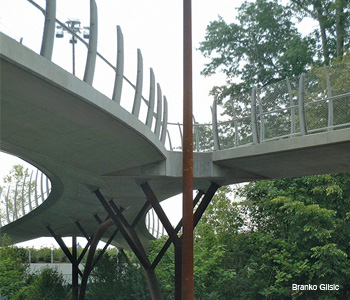 The Streicker pedestrian bridge at Princeton University, where a multitude of fiber-optic sensor trials are under way.
The Streicker pedestrian bridge at Princeton University, where a multitude of fiber-optic sensor trials are under way.
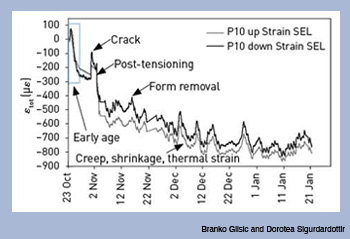 Readout from one of the columns (P10) holding up the bridge’s southeast leg (SEL). Two sensors are used in that area and labeled as “up” and “down,” with the “up” sensor closest to the bridge’s top surface. Strain in both sensors was tracked over the three months after the concrete was poured.
Readout from one of the columns (P10) holding up the bridge’s southeast leg (SEL). Two sensors are used in that area and labeled as “up” and “down,” with the “up” sensor closest to the bridge’s top surface. Strain in both sensors was tracked over the three months after the concrete was poured.
 Fiber-optic sensors mounted on the Streicker Bridge also show the changes in the curvature (bending due to strain) of the southeast leg between columns P10 and P13. Curvature is measured as the amount of strain (ε) per unit length. FEM = finite elements method, a statistical analysis of the spectral data.
Fiber-optic sensors mounted on the Streicker Bridge also show the changes in the curvature (bending due to strain) of the southeast leg between columns P10 and P13. Curvature is measured as the amount of strain (ε) per unit length. FEM = finite elements method, a statistical analysis of the spectral data.
A bridge, strained
Glisic has a civil engineering background, but he has been working in the world of fiber optics since 1996. Prior to teaching, he spent seven years at Smartec SA in Switzerland, a company devoted to developing commercial possibilities for early fiber-optic sensors. When he moved to Princeton four years ago, though, a new application for fiber sensors was beginning to take shape.
The Streicker Bridge, which now provides a pedestrian walkway between two areas of the Princeton campus, was about to be built. Glisic and other members of the university’s SHM team took advantage by installing a pair of novel fiber-optic sensor systems into the concrete of the pedestrian bridge as it was poured.
Built in the campus’s “natural sciences neighborhood,” the bridge connects two sections of buildings divided by a road. It is uniquely shaped, stretching like a pudgy stick figure performing yoga across a distance of 300 ft. The bridge gets its unusual shape via a main span and four limb-like approaching segments composed of curved girders supported by steel columns.
The deck is just under 23-in. thick and has an arch constructed of tubing with a diameter of only 12.75 in. The SHM team has been using the pedestrian bridge for a variety of experiments ever since construction began on it in October 2009.
“Most of my sensors look for strain,” Glisic said. “Strain relates to stress; when you get to a certain amount of stress, you have a (structural) failure.” In these applications, strain is the distance a material deforms as compared to its original length, and the resulting dimensionless figure is rated in epsilons (ε).
Using the fiber-optic strain gauges, Glisic said, engineers can look for failure cracks as well as overall strain. In the Streicker Bridge, gauges are set to detect temperature as well as strain.
One of the installed systems is a discrete, long-gauge device, which collects strain (or temperature) data at individual points within the poured concrete. The other system is a distributed sensor in which data can be collected from any point along the fiber’s length. The long-gauge system gets readouts using fiber Bragg spectrometry techniques, while the distributed sensor uses BOTDA.
In one experiment, Glisic and his colleagues attached a few pairs of discrete sensors close to the axis of symmetry in several cross-sections of the southeast leg of the bridge. The sensors monitor the normal and bending forces placed on the structure, focusing on the most heavily loaded parts, the sections above each column and the middle of each span between columns.
In addition, the group has installed distributed sensors between the main columns of the southeast leg, which are used to monitor strain (and temperature) along the entire span, not just the spots with the heaviest loads.
On a somewhat different scale, Farhad Ansari and his associates at the University of Illinois at Chicago have installed fiber-optic sensors on the brick masonry vaults of the iconic Brooklyn Bridge in New York City. These vaults, which support the bridge structure on the Manhattan side of the East River, have supported huge loads since the bridge was completed 130 years ago, but they are now riddled with longitudinal cracks along their crowns. Ansari’s group needed to set up a monitoring system and assess whether there is safety issue related to these cracks.
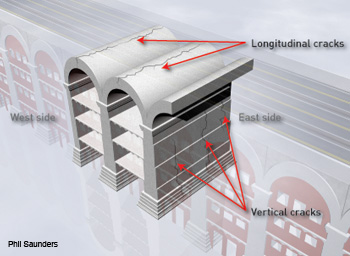 Analysis of cracks on the Brooklyn Bridge: Researchers used fiber-Bragg-grating–based sensors to determine that the cracks along the crown of the bridge are not widening significantly and thus pose no immediate thread.
Analysis of cracks on the Brooklyn Bridge: Researchers used fiber-Bragg-grating–based sensors to determine that the cracks along the crown of the bridge are not widening significantly and thus pose no immediate thread.
The group used a series of fiber-Bragg-grating-based sensors to measure crack formation, displacement, temperature and other forces. The crack sensors, in particular, were placed along the longitudinal cracks along the vaults’ crowns, but also along cracks in the vaults’ three-story-tall walls. In addition, the researchers installed fiber-optic accelerometers on each side of the longitudinal cracks. The sensors were designed by the group to measure an opening from 0.02 to 10 mm with 0.5 nm/mm sensitivity.
Over time, the sensors measured negligible ongoing perturbations in the structure of the vaults, finding maximum displacements of 36 µm per week. The sensor data also enabled the group to assess that the vault cracking does not yet warrant further maintenance or repair, but that continual monitoring would likely tell when the vaults were approaching their safety limits.
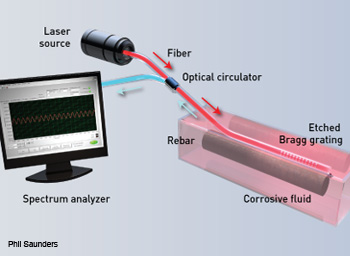 Detecting corrosion: Setup used by researchers in Malaysia to study corrosion in the rebar used to reinforce concrete. The fiber is etched to allow a portion of guided light to sample the environment.
Detecting corrosion: Setup used by researchers in Malaysia to study corrosion in the rebar used to reinforce concrete. The fiber is etched to allow a portion of guided light to sample the environment.
Fighting corrosion
At the University of Malaya, the focus is not on cracks but rather decay—specifically, corrosion that takes place on metal structures and substructures, such as the metal rebar used in reinforced concrete. Faisal Rafiq Mahamd Adikan, who formed the Photonics Research Group at the university’s faculty of engineering, leads the charge there.
“We saw a growing acceptance of photonics-based sensors in structural health monitoring in general,” Adikan said. But not in Malaysia—which is odd because the country is perpetually hot and humid, especially along the coasts. If the corrosion of rebar and similar structures goes undetected for too long, the metal weakens and ultimately fails.
Adikan and his team attached fibers etched with fiber Bragg gratings directly to rebar samples and placed them into a corrosive liquid. The caustic environment alters the refractive index of the region within the immediate vicinity of the gratings, thus altering their effective refractive index. This held true even when the corrosive material couldn’t reach the rebar because of the placement of the fiber. Adikan’s group believes that the resulting change in the spectral signal is due to both localized and non-localized effects.
“The non-localized (effect) is mainly in the form of stress,” he said. “The localized one is probably due to refractive index changes following oxidation.”
He added that the underlying cause of corrosion is of no consequence to the spectral changes that occur, although there are as-yet-unexplained “jumps” in the spectral behavior.
Ultimately, working on rebar will provide a proof of concept that will provide insight into how to address the persistent problem of corrosion experienced in any sea-wrapped locale. The group also has installed a fiber Bragg grating sensor into a bridge south of the capital, the first such installation in Malaysia.
“The vision is to have these sensors installed in offshore oil platforms, ports, vessels, underground water pipes (and) chemical process reaction chambers,” Adikan said.
Hybrid systems
Distributed and point-sensing techniques provide strain and temperature readouts separately, but as the SHM model takes hold, building designers will want to keep watch on every parameter possible. The various techniques needed to acquire every desirable data point would seem to preclude using just one fiber system in any given installation, but one group of researchers in Italy has other ideas.
Fabrizio Di Pasquale of Scuola Superiore Sant’Anna in Pisa and his colleagues are exploring systems that would provide both distributed and discrete readouts simultaneously. The group is working with FiberSens S.r.l., a spin-off company of the applied sciences university, developing and marketing fiber-optic sensor systems.
Simultaneous measurement of distributed temperature and discrete dynamic strain fields would be useful for several applications, including industrial plant monitoring, micro-leakage detection in oil and gas wells, and fire detection in long rail and road tunnels. For that reason, Di Pasquale’s team decided to develop hybrid sensor systems.
In the 1 Nov. 2012 issue of Optics Letters, the investigators describe a system that uses a single pulsed laser to generate both Raman and fiber Bragg grating signals. The laser generates a telecom-standard wavelength of 1,550.5 nm, drives it through an attenuator, and generates pump pulses of 33 dBm peak power at a width of 10 ns. The hybrid device is a bit less sensitive than stand-alone systems, but it produced a temperature resolution of 2° C at nearly 11 km away in lab tests and a dynamic strain resolution of approximately 60 nε/Hz½.
The light source used to drive any fiber-optic sensor is an important consideration. Systems based on fiber Bragg gratings are the simplest; they run satisfactorily either with broadband incoherent light sources or with narrow-band pulsed lasers, depending on the multiplexing technique. Raman-based systems, however, may demand high peak power broadband pulsed lasers.
Di Pasquale’s hybrid system requires even more. “The light sources to be used in hybrid sensor systems for simultaneous distributed temperature and discrete dynamic strain measurements have rather demanding specific requirements,” he said. “In particular, (both) high peak power levels and narrow band laser sources are needed.”
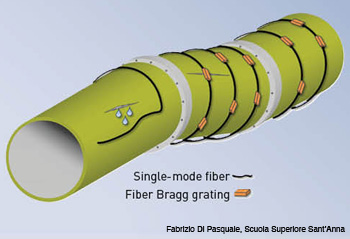 Profiling a pipeline: Temperature profiling throughout a pipeline—together with dynamic vibration information at various critical points—can effectively detect overheating, leakages, fires or other anomalies. Both the fibers and Bragg gratings can be embedded inside the pipe during fabrication.
Profiling a pipeline: Temperature profiling throughout a pipeline—together with dynamic vibration information at various critical points—can effectively detect overheating, leakages, fires or other anomalies. Both the fibers and Bragg gratings can be embedded inside the pipe during fabrication.
Stress-ful challenges
The market for fiber-optic sensors for SHM is small at present, Princeton’s Glisic said, so fiber makers aren’t in a hurry to tailor their products to the field. Sensors and related equipment, such as Brillouin scanners, are less expensive now than they were 10 years ago, which is helping to advance research—and this trend is expected to continue in the next decade or two.
Current fiber-optic sensor technology is based on a complex set of discrete optical and electronic components, including pulsed lasers, photodetectors, modulators, switches, optical filters, electrical current and voltage amplifiers, and more, Di Pasquale said. He contends that these features, especially the requirement of discrete optoelectronic components, make current fiber-optic sensor systems bulky and costly, limiting their use to low-volume niche applications.
“We believe that a key point to increase the market volume of fiber-optic sensors is integration,” he said. “Emerging technologies like silicon- and InP-based photonics will allow the integration of most sensor reading unit functions at (the) chip level, strongly decreasing the fabrication cost and opening the way to mass-scale applications, such as smart structures embedding fiber Bragg gratings, as well as distributed fire-detection systems.”
The field could progress faster, Glisic added, but for the natural “conservatism of civil engineering.”
“I think that the conservatism is related to structural health monitoring in general rather then to the SHM with fiber optic systems,” he said. “Thus, I think that bridging (the) educational gap between researchers and practitioners is one of the important factors.”
He added that two equally important issues are the development of better SHM methods, including the sensors themselves, the sensor network architecture and the algorithms used to analyze data, as well as sound proofs of cost-effectiveness.
“The overall aim of the Streicker Bridge project is to address all three factors,” he said.
Yet more novel applications are coming. Some groups are looking at using fiber optics to detect acoustic signals within structures. It would also be useful to monitor pH, chloride concentration and sulfate penetration in concrete, Glisic added. In addition, there is interest in making fiber-optic systems wireless at the sensor level, in creating Bragg gratings that are less temperature dependent, and in developing reading units that are less energy-dependent.
“Some people want to study strain; others, displacement or vibrations,” Glisic said. “For some of these techniques, fiber optics are more expensive; however, their longevity makes them worthwhile.”
Lynn Savage is a freelance writer who specializes in science and technology. He is the owner of Savage Editorial Services, Northampton, Mass., U.S.A.

